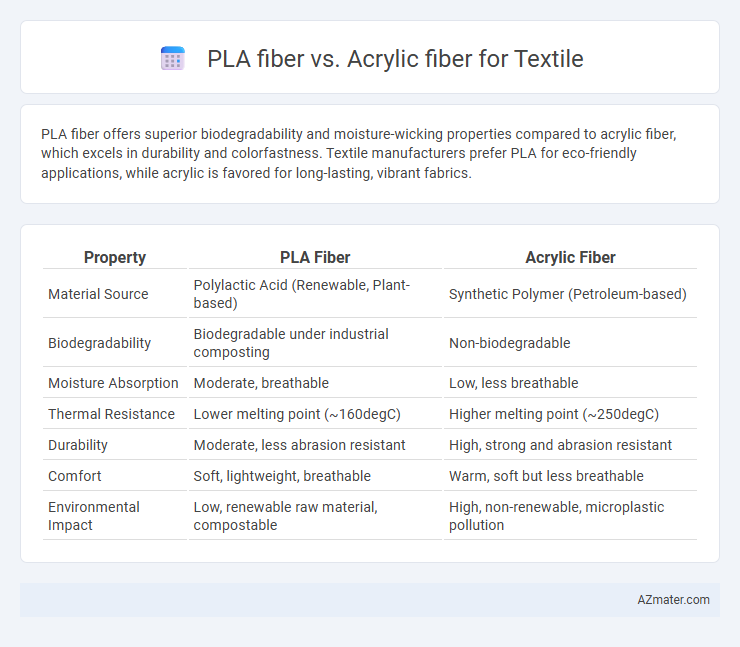PLA fiber offers superior biodegradability and moisture-wicking properties compared to acrylic fiber, which excels in durability and colorfastness. Textile manufacturers prefer PLA for eco-friendly applications, while acrylic is favored for long-lasting, vibrant fabrics.
Table of Comparison
| Property | PLA Fiber | Acrylic Fiber |
|---|---|---|
| Material Source | Polylactic Acid (Renewable, Plant-based) | Synthetic Polymer (Petroleum-based) |
| Biodegradability | Biodegradable under industrial composting | Non-biodegradable |
| Moisture Absorption | Moderate, breathable | Low, less breathable |
| Thermal Resistance | Lower melting point (~160degC) | Higher melting point (~250degC) |
| Durability | Moderate, less abrasion resistant | High, strong and abrasion resistant |
| Comfort | Soft, lightweight, breathable | Warm, soft but less breathable |
| Environmental Impact | Low, renewable raw material, compostable | High, non-renewable, microplastic pollution |
Overview of PLA and Acrylic Fibers
PLA fiber, derived from renewable resources like corn starch, offers biodegradability and excellent moisture-wicking properties, making it ideal for eco-friendly textile applications. Acrylic fiber, a synthetic polymer known for its softness and wool-like feel, provides high durability, colorfastness, and resistance to UV radiation and chemicals. Both fibers serve distinct roles in the textile industry, with PLA emphasizing sustainability and comfort, while acrylic focuses on resilience and versatility in various fabric blends.
Raw Materials and Production Processes
PLA fiber is derived from renewable resources like corn starch or sugarcane through a fermentation process, making it a biodegradable and eco-friendly option in textiles. Acrylic fiber, synthesized from polyacrylonitrile through polymerization of petroleum-based raw materials, involves energy-intensive chemical production with limited biodegradability. The production of PLA fibers typically consumes less fossil fuel and emits fewer greenhouse gases compared to the conventional acrylic fiber manufacturing process.
Mechanical Properties and Durability
PLA fiber exhibits superior tensile strength and stiffness compared to acrylic fiber, making it more suitable for applications demanding high mechanical performance. While acrylic fiber offers greater elasticity and resistance to abrasion, its durability under UV exposure and moisture is generally lower than PLA fiber. Consequently, PLA fibers provide enhanced longevity in outdoor textile uses, whereas acrylic fibers are preferred for flexible, lightweight apparel.
Environmental Impact and Sustainability
PLA fiber, derived from renewable resources like corn starch, offers excellent biodegradability and a lower carbon footprint compared to acrylic fibers, which are petroleum-based and non-biodegradable. Acrylic fiber production emits significant greenhouse gases and relies heavily on fossil fuels, contributing to environmental degradation. PLA fibers support a sustainable textile industry by reducing reliance on synthetic materials and facilitating compostable end-of-life options.
Comfort and Wearability Factors
PLA fiber offers superior moisture-wicking properties and breathability compared to acrylic fiber, making it more comfortable for prolonged wear, especially in warm climates. Its biodegradable nature and soft texture enhance skin compatibility and reduce irritation risks, unlike acrylic fiber which can feel less breathable and cause static cling. PLA's lightweight and natural elasticity contribute to better fit and wearability, positioning it as a preferred option for eco-friendly and comfortable textile applications.
Dyeability and Color Fastness
PLA fiber exhibits excellent dyeability due to its high affinity for disperse dyes, resulting in vibrant and uniform colors in textile applications. Acrylic fiber shows superior color fastness, especially against sunlight and washing, making it ideal for outdoor and durable textiles. However, PLA's dye uptake can be enhanced through surface treatments, narrowing the gap in performance between these fibers.
Cost Comparison and Market Availability
PLA fiber offers a cost advantage due to its renewable raw materials and lower processing energy, making it increasingly competitive against traditional acrylic fiber, which is petroleum-based with more volatile pricing. Acrylic fiber maintains stronger market availability and established supply chains worldwide, supported by extensive industrial infrastructure and widespread use in apparel and home textiles. Market trends indicate growing adoption of PLA fiber driven by sustainability demands, yet acrylic fibers still dominate in terms of volume and global accessibility.
Applications in the Textile Industry
PLA fiber offers excellent biodegradability and moisture-wicking properties, making it ideal for sustainable activewear and eco-friendly fashion textiles. Acrylic fiber delivers superior warmth, color retention, and durability, widely used in sweaters, upholstery, and outdoor wear. Both fibers serve distinct niches in the textile industry, with PLA favored for environmental benefits and acrylic prized for performance and versatility.
Care, Maintenance, and Lifespan
PLA fiber offers superior biodegradability and requires gentle washing at low temperatures to maintain fabric integrity, extending its lifespan when properly cared for. Acrylic fiber is more resistant to moisture and stains, allowing for easier machine washing and quicker drying, but it tends to experience pilling and color fading over time, impacting durability. Regular maintenance with mild detergents and avoiding high heat during drying optimizes the longevity of both fibers in textile applications.
Future Trends and Innovations
PLA fiber, derived from renewable resources like corn starch, is gaining traction in the textile industry due to its biodegradability and lower carbon footprint compared to traditional acrylic fiber, which is petroleum-based and less eco-friendly. Innovations in PLA fiber production focus on enhancing its mechanical properties and dyeability to compete with acrylic's durability and colorfastness, addressing performance gaps for broader textile applications. Future trends emphasize the integration of advanced bio-based composites and recycling technologies to promote sustainability and circular economy models in textile manufacturing.

Infographic: PLA fiber vs Acrylic fiber for Textile
 azmater.com
azmater.com